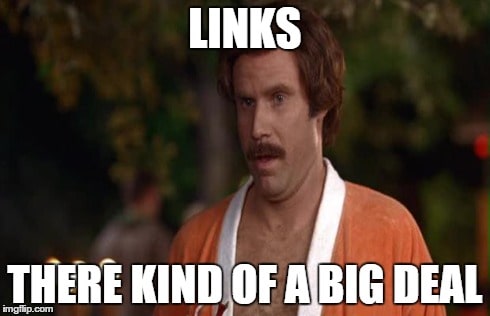Are you having trouble getting your business to page one in the organic rankings, the holy grail of digital marketing? Are you not showing up in the local map results? There could be a host of reasons why you are not showing up where you want, but one of the most common problems we see is that business don’t have any good links pointing to their site.
Recent Google algorithm updates have put more emphasis on the quality of your content. Focusing on whether or not it exhibits a high level of expertise, authoritativeness, and trustworthiness ( E.A.T ) but links are still a prominent factor in getting your pages to rank well, and in many causes help with your E.A.T. level.
WHAT ARE BACKLINKS?
A backlink is a link that takes a user from someone else’s website to yours. There’s basically two main types of links which are follow and no-follow links. When a website links back to you with a follow link they’re basically saying to search engines and users that “hey, this content is pretty good, we think you should go take a look”. A no-follow link is used when you don’t want to vouch for another website and give them that vote of approval. Google looks at the amount and, more importantly, the quality of the sites who are linking to your website as an indicator of value you are providing readers.
Since link-building has been abused by SEO peeps over the years to manipulate rankings, search engines like Google and Bing have become smarter about what qualifies as a worthy link. Quality very much beats quantity at this point. Google looks at a few different factors to determine the quality of your links.
- Do your links come from websites in a niche or related industry?
- Do your links come from trusted websites? How authoritative is the website linking to your site?
- Does the anchor text for your links look natural and is it applicable to the content?
- Are your links relevant to your content and do they deliver value to the user?

WHAT’S THE DIFFERENCE BETWEEN TRADITIONAL BACKLINKS VS. LOCAL BACKLINKS?
One of the main differences between typical backlinks and local backlinks is that websites will often try to build backlinks from websites that have the highest domain authority whereas local businesses will often get more value from local links even if those websites have less authority.
A link from a local business is highly relevant and has the added bonus of creating awareness for your business with your targeted, local audience.
HOW DO I GET MORE LINKS FOR MY LOCAL BUSINESS?
1. LOCAL CITATIONS
Having consistent NAP info ( Name, Address, Phone Number ) for your business across the most prominent citations is an essential piece of the puzzle for a successful local SEO strategy and key to your link building tactic.
Wait, I heard that links from local citations are no-follow? Generally, the answer is yes but there are many citation sites with dofollow links that pass “link-juice” to help you rank better. Keep in mind that many local SEO professionals rely heavily on this tactic for link building and links from local citations alone likely won’t be enough to reach your goals. You have to kick it up a notch, so keep on reading!
2. LOCAL/NICHE DIRECTORIES
Regardless of where you’re located or what type of business you run there’s most likely some directories that are applicable to your business. As with local citation links, this isn’t a great tactic to differentiate your website from competitors but it’s a nice way to get started. If you’re a Kitchener-Waterloo business here’s a few local links to get the ball rolling.
- KWNow
- City of Waterloo Business Directory
- Waterloo Region Business Directory care of The Record
- Check with your local business association
- If you are into Manufacturing, check out the Manufacturing Innovation Network
3. LOCAL BUSINESS RELATIONSHIPS
If you’re a local business there’s a good chance that you know some other local business owners, these relationships are gold! For example, if you a home renovator you may have relationships with other home service providers like roofers, landscapers, plumbers, or electricians that can link back to you. Start fostering these relationships so you can send and receive referrals both online and offline to grow your business.
4. GUEST POSTING ON LOCAL WEBSITES
Needless to say content marketing is still on the rise, and we doubt it’s going to change any time soon. Although guest blogging requires time and effort, it will definitely pay off with links, visibility, new audience, and relevant traffic. If you’ve been working on building those business relationships mentioned in method #4, then that’s a great place to start. But first and foremost, quality guest blogging starts with searching for relevant opportunities.
5. COMPETITOR RESEARCH
Your top ranking competitors likely have some good links so doing a little digging around can be a valuable approach. You can use competitive analysis tools such as SemRush or Moz to see your competitor’s best links. Start by creating a Google Spreadsheet or Excel doc and list out all the websites where your competitors appear and identify the ones you like. If this is already feeling a bit overwhelming, Side By Side offers SEO audits and competitive research as part of our SEO packages, hit us up if you need help!
6. LOCAL SPONSORSHIPS
Does your business support the local soccer team or your favourite local charity? Many of these organizations have websites that link out to supporters which can be good for business.
You could try using a Google search like this ( [Kitchener] inurl:sponsorships ) to find some of these local opportunities but likely the best choices won’t be found via this search. Get out there and involved in your local community and find some ways you can help out. You get to help your community and, as an added bonus, get a link!! ?
That’s it for our 6 local link building tactics to get you on your way to ranking top of page. Let us know in the comments if you are using any of the above mentioned or if there is something working for you that we missed!!



